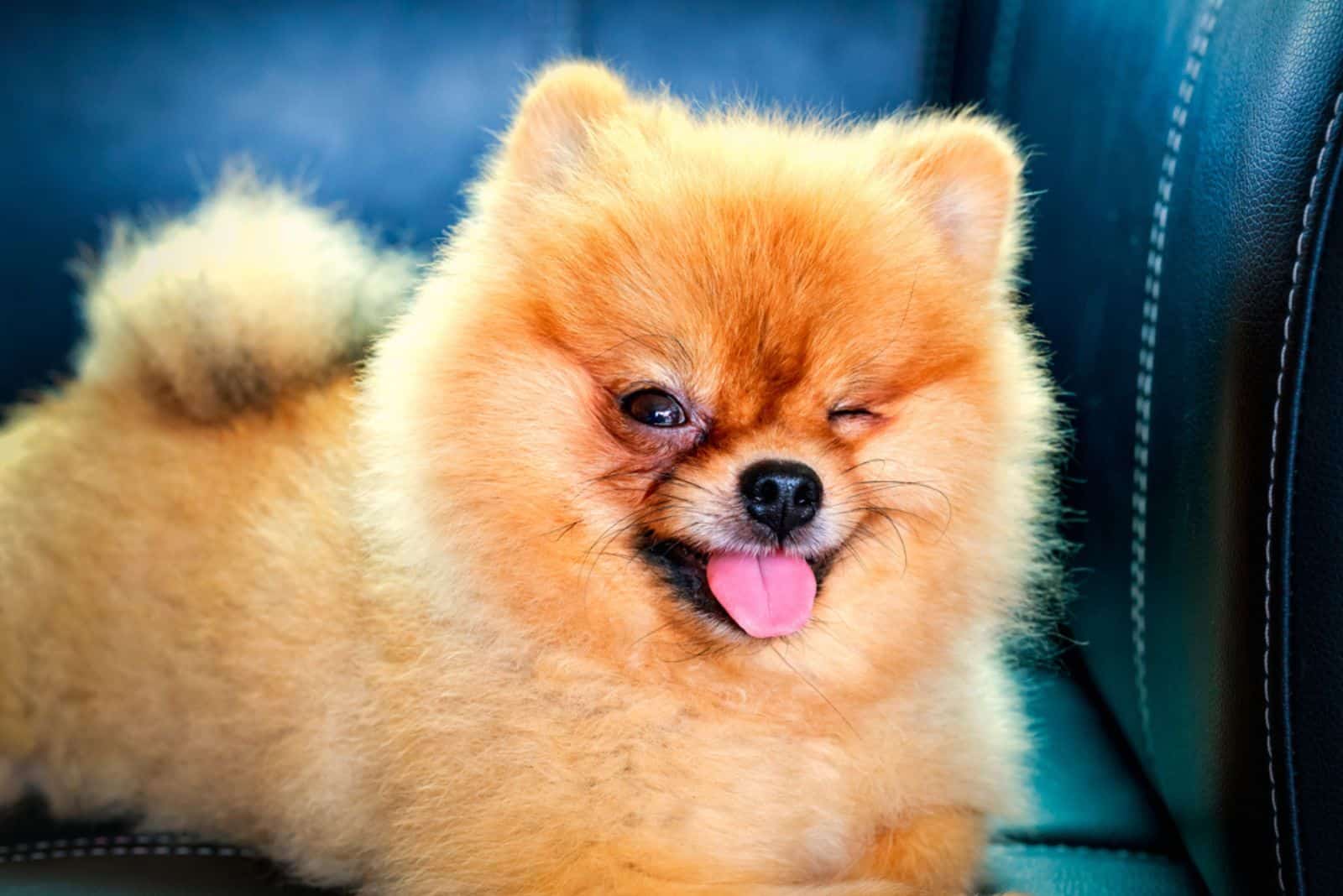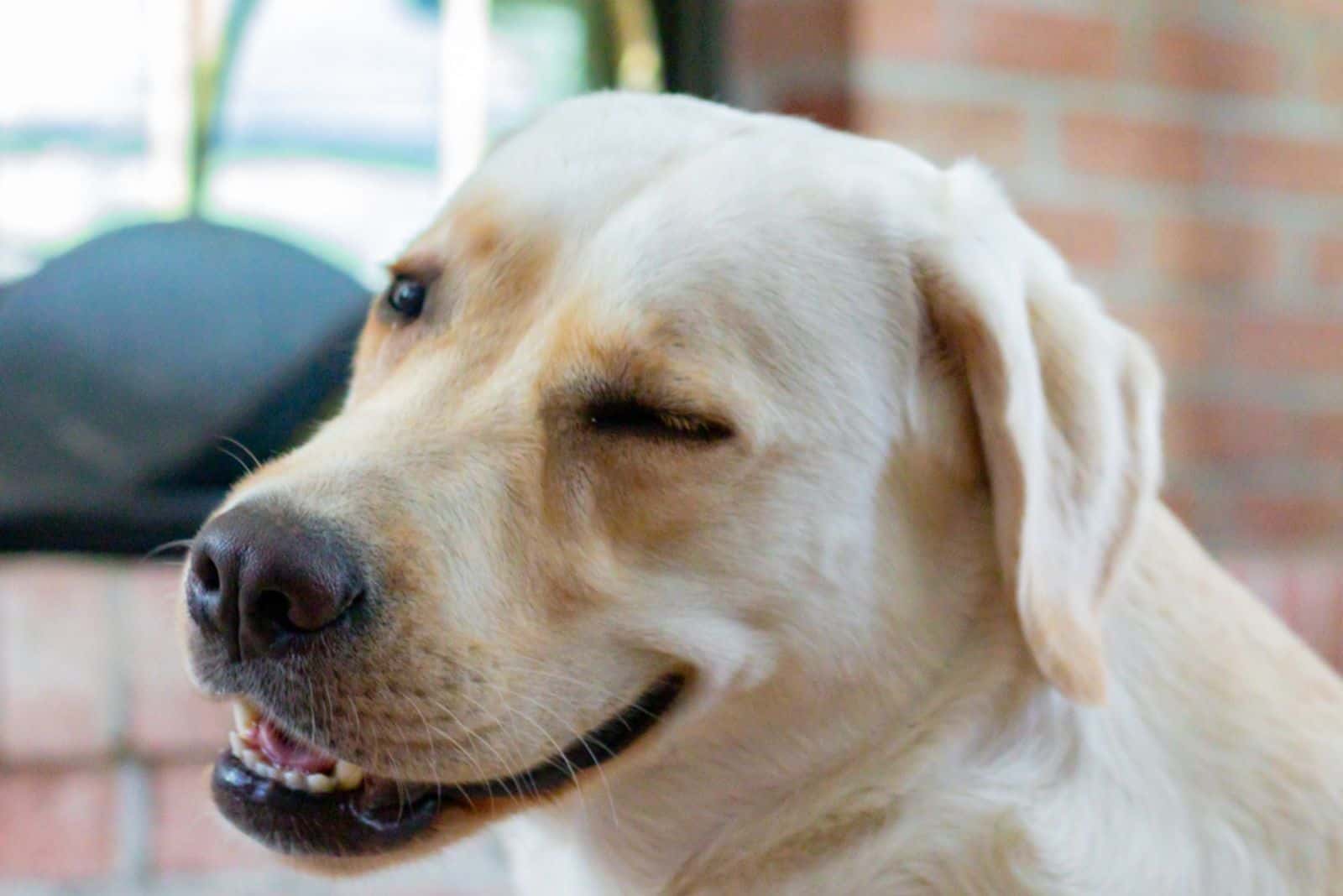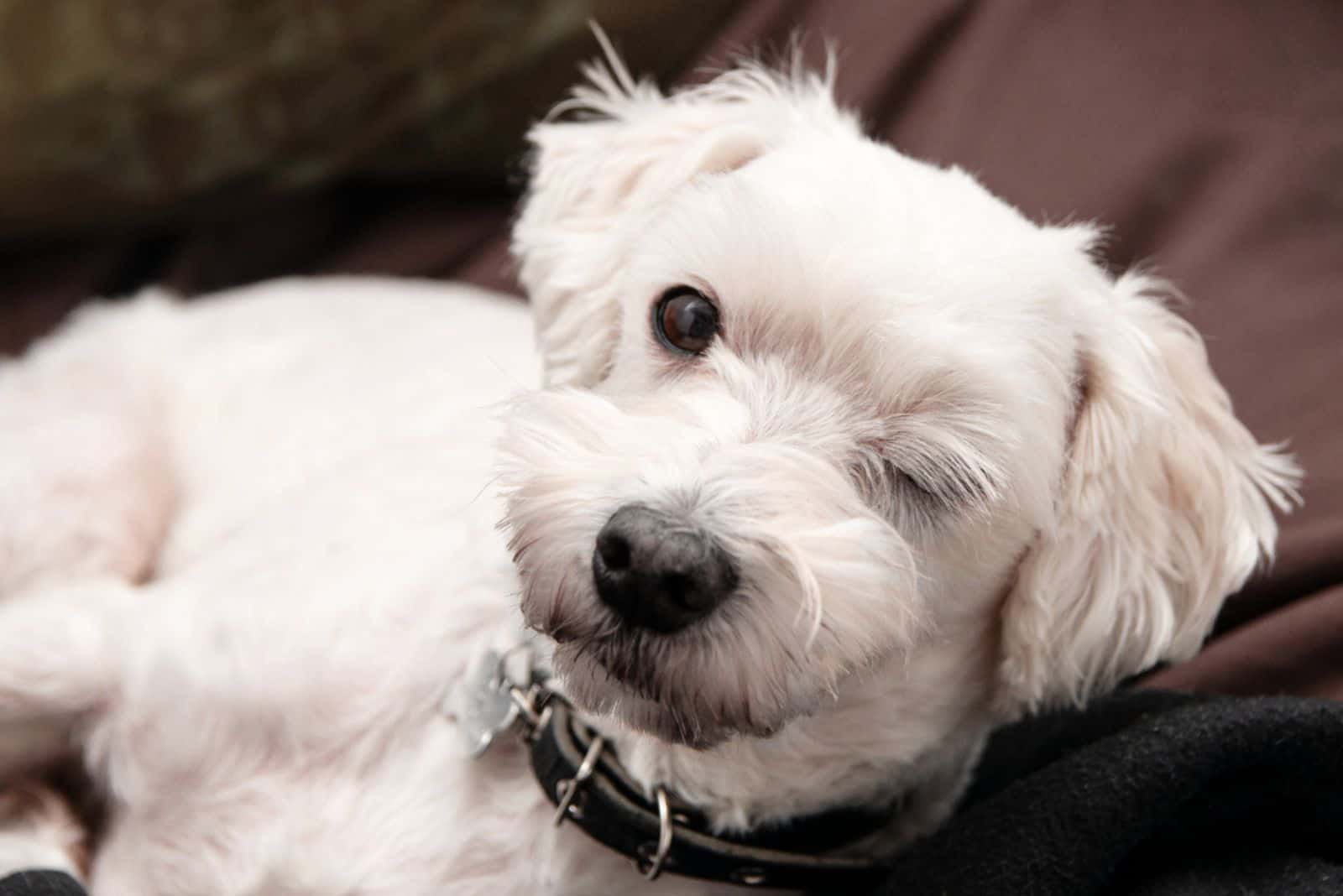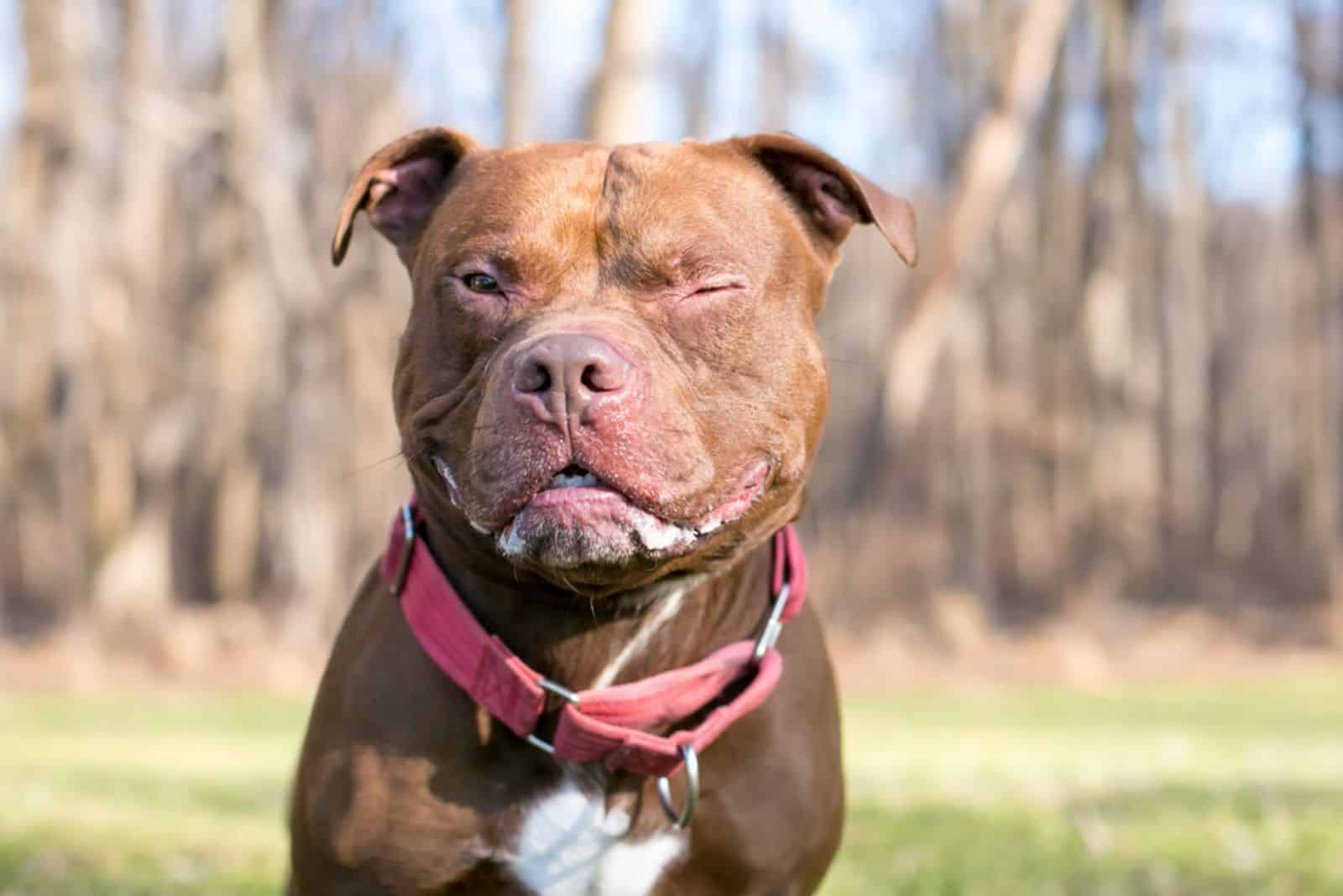Have you ever seen a dog wink at you? When you see it for the first time, it is a moment of surprise and happiness at the same time. We feel special — a dog winking at us is a special thing!
And, if it happens more than once, we start thinking, why do dogs wink? Is it trying to say something? Or, is there a health issue behind this seemingly innocent and cute behavior?
It sure is some kind of sign that something is happening inside our doggo’s brain or body. Whatever it is, as pet parents, we want to be sure that everything is alright with our pooches.
We don’t want to overlook a possible health problem. That’s why we’ve got seven possible reasons behind such interesting dog behavior.
Whether it is body language or some kind of a health issue with the dog’s eye – we’ve got it covered. Although, in most cases, I guess the dog is just saying: Hi there…
But, instead of just winking back at the dog (or trying to), let’s find out more about it.
Why Do Dogs Wink?
As mentioned before, in most cases, it is a dog’s way of saying something like, “hello, it’s me”. They’ve heard you listen to Adel’s song more than just a couple of times (who hasn’t?) so they are just copying whatever you do.
But, sometimes it can be a sign of something health-related. But, don’t worry — most of the time, it is a passing eye irritation or something similar.
Just in rare cases, the problem can be more serious. You should pay attention to other symptoms like the dog rolling its eyes back or something similar. If you see more than one symptom and not only winking, then taking your dog to the vet is the best option.
But, this time, we’re talking about dog winking, and we will talk about all of the issues — from simple facial expressions to various eye problems.
These are the seven possible answers to the question: why do dogs wink?
1. Irritation

The most common reason behind a dog’s occasional winking is eye irritation. This is not the same as an eye infection — that is a health-related reason.
Irritation of the eye can happen for various reasons. Most of them are quite simple and benign, and they go away without any treatment. I am talking about simple dust irritation that caused your doggo to become a winking dog!
Dogs love to explore and sniff around. They are famous for sticking their nose everywhere — literally! So, an occasional foreign body (no matter how small it might be) can end up in our dog’s eyes and cause some mild irritation.
The natural and automatic way of the body — dog’s included, is to “wash away” the irritation. The washing away happens when a dog blinks. That is when tears from the nearby tear ducts get smeared all over the eye.
Tears work as a lubricant for the eye, and they do a great deal of protection, too. One way is carrying dust particles away from the eye.
You might notice that your dog’s eye is red or that it produces more tears than usual. These are also signs of eye irritation. It happens the same way as in our eyes. If you’ve ever experienced any form of eye irritation for known or unknown reasons — you know what I am talking about.
If you notice other signs on your dog that are unusual when you combine them, like noticing your dog sneezing a lot, rubbing its face on the carpet, etc. — then there is a possibility it is more than just an eye problem.
It could be something related to the nose, mouth, or ears, and it is very important to take your dog to the vet. The vet can give you a definite conclusion as to what the problem is and answer your question — why do dogs wink?
2. Infection

Just like there are many reasons for eye irritation, there are also many reasons for eye infection. Most eye infections are easily treatable, especially if they are diagnosed at an early stage.
You might notice some other changes in your dog’s eye or around your dog’s eye, or you might see a change in the dog’s behavior.
It can be something obvious like a dog trying to rub its eye with its paw or it can be a vague symptom, like a dog acting weird all of a sudden. But, most eye infections are quite obvious because often, an irritation causes eye color change or another visible sign.
So, why do dogs wink? An infection can be a reason. As a matter of fact, there are more than two symptoms as to why your dog might have an infection of the eye:
- The red color of the eye
- Swelling of the surrounding tissue
- Excessive winking
- Discharge
- Excessive tearing
- Rubbing the eye with a paw
- Sensitivity to light (photophobia)
- Having problems opening the eyes
These are the most common symptoms pointing to an eye infection. But, they can be symptoms of different types of diseases. Most infections are of viral or bacterial origin. But, sometimes an infection can be of fungal origin.
Most eye infections with a fungal origin have other, much more visible signs of a fungal infection of the body. For example, noticing that your dog is losing hair around the eyes is one of the possible signs of an infection that spreads to the eyes or to one eye.
And, yes — the infection can happen in one eye or both eyes at the same time. In most cases, the infection happens in one eye only, but if it is not treated, it can spread to the other eye. It spreads because of the dog’s (futile) attempts to “clean” the eye by rubbing the eye with its paw.
What Are Common Types Of Infection?
Just like any other species, dogs are more prone to some types of infections than others. It has to do with the anatomy, physiology, and current status of the immune system of the dog.
This means that there are types of infections that happen the most in dogs of all ages. Although the infection can happen at any age, it is more common in very young dogs and old dogs.
Why? Because their immune system is either undeveloped (young dogs) or not strong enough (old dogs) to fight the infection.
Here are some of the most common eye infections in dogs:
- Inflammation of the cornea
- Uveitis (inflammation of the inner parts of the eye)
- Conjunctivitis
- Tear duct inflammation or abnormalities
When some of these infections happen, your dog won’t be doing a cute wink all the time. Maybe this will be the case at the beginning of the infection. But, as time goes by and the inflammation continues to spread — the symptoms will change.
Canines are not capable of telling us what is wrong with them. They can show signs that something is not working in their doggy body, but we can’t be sure unless there is a more obvious sign.
That’s why it is important to pay attention to your dog’s winking habit. If it’s just occasional and there are no other mentioned symptoms — all is well, and you should wink back at the dog.
But, if you notice swelling, redness, or pain — you know the drill. Take the dog to the vet. It might be nothing, but it might be something. I always go by the rule, better safe than sorry, when it comes to my pets.
3. Blepharitis

This is a health condition that can affect one or both eyes. It is the inflammation of the eyelids. It is different from an infection because blepharitis can happen without viruses or bacteria. It can happen because of all kinds of irritants — from foreign bodies to tumors.
The most common sign of blepharitis is blepharospasm — winking. The dog winks for the same reason as before in other cases – they want to get rid of the problem.
Unfortunately, winking won’t solve the problem. Neither will something else dogs do — rubbing their face on the carpet or rubbing their eye with their paw.
There are other signs to look out for:
- Swollen eyelids
- Red eyelids
- Itchy eyelids
- Eye soreness
Itchiness might turn into pain if the condition remains untreated. A swollen eyelid doesn’t have to be an infection of viral or bacterial origin. It can be an allergic reaction as well. It can also be your dog’s body’s response to trauma.
If your dog hurts his eye somehow, the body reacts by swelling up and changing its original form. Redness and pain can also be present. We usually notice when our dog hurts itself, but we can’t pay attention to their behavior all the time, especially if you let your dogs run around freely in the yard or in the dog park. All kinds of things can happen. So, it is alright if you didn’t witness what happened — when you notice that your dog’s eyelid has changed shape or is swollen, take your doggo to the vet.
Are Some Breeds More Prone To Blepharitis?
The direct answer is — yes.
There are some dog breeds that are more prone to developing blepharitis and consequential excessive winking. These dog breeds have one thing in common — they are brachycephalic dog breeds.
That means they have a sort of anatomical deformity that causes them to be more prone to developing diseases and health issues of the eyes. Because of the same reasons, these dogs have problems breathing, too.
Breeds prone to blepharitis are:
- Bulldogs
- Shih Tzus
- Pugs
- Lhasa Apsos
Besides allergies, traumas, and infections — there is something called idiopathic blepharitis. This is the case when we do not know what is the cause of this health condition. Simply put — the reason is unknown.
If this is the case, the answer to the question of why do dogs wink could be — we don’t know.
4. Submissive Behavior

We all know that dogs do not communicate the same way we do. We use words and body language to speak our minds, but dogs are not as vocal as we are. Or, we don’t pay attention to body language as much as dogs do.
If you pay attention to two dogs when they see each other for the first time, there are certain ways the dogs act in order to say — I am friendly, or I rule! In other words, a dog uses its body to show its dominance or submissiveness.
The first step is eye contact. But, if the eye contact continues and one dog stares at the other dog — there could be trouble. It is a clear sign that they are not submissive, and they want to show dominance.
There are other ways a dog shows how it feels in relation to other dogs (or people). For example, a submissive dog will show its belly or tuck its tail between its legs.
An aggressive dog will stiffen, show its teeth, growl, or lunge. They are showing the other dog that they are the alpha in the pack. Of course, such behavior can be avoided if we socialize our dogs at an early age.
If you got your dog as an adult and not a puppy – don’t worry. There are ways to socialize an aggressive dog, but it might take more patience, lots of positive reinforcement training, and time. After all, you are trying to remove old behaviors and make new behaviors in your dog.
So, what does this have to do with winking and answering the question of why do dogs wink? Well, because winking is also a sign of submissive behavior in dogs. This special kind of moment between your dog and you can mean you are the woman (or man) of the house!
As much as we might not think of it that way, dogs have a “pack” behavior, and they will always unconsciously think of us as members of their pack. And, any pack must have an alpha dog — you.
So, your doggo is winking at you as a form of telling you who is the boss. And, you have to act as one – not aggressively, but show that you say what is OK to do and what is not OK.
If not, your dog can show signs of bad behavior — biting, not listening to commands, and even aggression. That is because they think they are the alpha dog in the house.
5. Showing Affection

This reason goes hand in hand with the previous one. Dogs can wink to show submissiveness and affection at the same time.
There are other ways they show us affection, of course. For example, dogs nibble or put one side of their muzzle on our body as a way of leaning, and of course, they give us lots of kisses! So, if you are wondering why your dog licks you — think of it as doggy kisses!
Winking is another form of how they show affection. You should be happy and feel special when you see a dog wink at you… of course, if the winking is not health-related.
But, in most cases, it is not. It’s a way a dog communicates with us. They’ll do all kinds of things, and winking is one of those things that make our heart melt!
6. Entropion

This is another medical explanation and an answer to the question of why do dogs wink. What is entropion? It is a health condition when the eyelid flips inward.
This health condition can be very painful for doggies. This is because the hair goes in together with the eyelid, and the inward-facing hair touches the surface of the eye, which causes pain. This can also cause redness of the eye or increased lacrimation.
When this problem happens, dogs will show signs such as:
- Redness of the eye
- Rubbing the affected eye with a paw (daily paw rubs)
- Winking
- Squinting
- Epiphora (eye discharge)
- Keeping the eye (eyes) shut
This can be a genetic condition, but it can also be just one of the symptoms of another type of disease.
When it comes to genetics, there are some dog breeds that are prone to developing entropion. There is no correlation between short-nose dogs (brachycephalic dogs) and entropion. This health condition can happen to numerous dog breeds, no matter the size or shape of their head.
Some of the breeds that are prone to developing entropion are:
- Golden Retrievers
- Pugs
- American Cocker Spaniels
- American Staffordshire Terriers
- Bernese Mountain Dogs
- Shih Tzus
As you can see, from tiny Pugs to huge Bernese Mountain Dogs, entropion is a health condition that does not occur in just one type of dog breed.
How To Treat It?
Entropion treatment has a good prognosis. It is permanently solved via surgical intervention in which a part of the inward-facing eyelid is removed. This removal is done so that the eyelid doesn’t rub the eyeball and other sensitive parts of the eye.
This surgical procedure might have to be done several times for a full recovery. Also, a dog cannot undergo surgery until it’s at least six months old.
Another fact for informational purposes regarding this health condition is that the vet will prescribe some kind of eye drop medication to prevent infection in the eye.
It also has to be mentioned that the prognosis of entropion treatment is good if it’s done at an early stage. If it’s done later in a dog’s life, the prognosis might not be as good. This can result in permanent partial or full loss of eyesight.
Can Entropion Affect Both Eyes?
Once again, the direct answer is — yes, it can.
This type of condition happens mostly in flat-faced dogs, and it is usually a type of entropion called Medial Entropion. This means the eyelid abnormality closes in the corner of the eye closer to the dog’s nose.
It looks like a red “bump” in the corner of your dog’s eye. An interesting fact is that in this case, it is not painful — or, at least the dog does not not show signs of any kind of discomfort. Another fact is that Medial Entropion doesn’t have to be as large as “normal” Entropion.
But, don’t worry — you will notice it even if your dog has no obvious signs of pain or if it’s smaller in size. Actually, it is usually noticed when the dog is under one year of age. This is a good thing because it is diagnosed early, which means the treatment prognosis is better.
7. Copying Behavior

This is my favorite reason and answer behind the “Why do dogs wink?” question. It is my favorite because it speaks so much about our lovely dogs’ brain!
Think about it like this — they are observing us and noticing our behavior. They learn what it means when we laugh or when we are loud, or when we wink! Have you ever winked at your dog before? I have!
I winked at my dog when I noticed he was looking at me. So, I had to ask, “is someone ready for a walkie?” and wink at him!
Now, just think about how many times you might have winked at your dog unconsciously. They are smart, they figured out that when we wink, we feel good and we show them affection. Our dogs are not only smart, but brilliant creatures that love to show how much they love us.
And, sometimes they try to do what we do and show affection in our way. That’s when they wink at us. It’s a cute and lovely way of saying, “I love you.”
I know winking is not an obvious sign that dogs show affection, or is not as obvious as a dog sitting on our lap, but it is an adorable sign!
So, when a dog winks at you — go and give it a hug!
The Conclusion
Why do dogs wink? There are seven possible reasons, and we’ve seen them all. Some are related to the dog’s health, while others represent a form of social behavior.
The social behavior connected to winking can either be pointed toward other dogs or at us. In either case, it is not aggressive social behavior, but either submissive or affectionate behavior.
And, unfortunately, yes – a case of a winking dog can be connected with a health issue or a health condition. But, luckily, most of them are not serious health problems. This is especially the case if we notice the change in its early stages.
But, once again, most of the time, a dog is either cleaning its eye from some dust particles or it is showing he’s at peace and feeling safe, so he had to wink at us to show us he loves us.
Whatever you think the reason might be, if it persists or if you notice it is getting worse, you shouldn’t wait for the symptoms to get “more obvious”. Taking your dog to the vet in this situation is the solution!
See next: Why Does My Dog Suck On Blankets?















